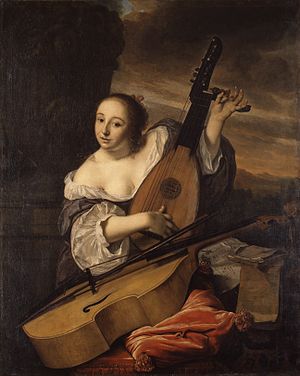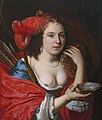
Gerbrand van den Eeckhout was a Dutch Golden Age painter and a favourite student of Rembrandt. He was also an etcher, an amateur poet, a collector and an adviser on art.
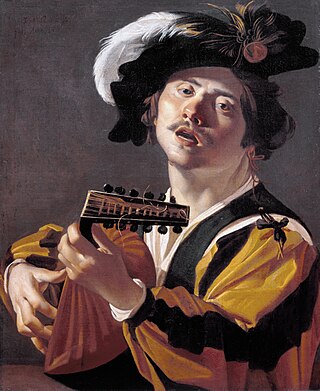
Dirck Jaspersz. van Baburen was a Dutch painter and one of the Utrecht Caravaggisti.

Nicolaes Maes was a Dutch painter known for his genre scenes, portraits, religious compositions and the occasional still life. A pupil of Rembrandt in Amsterdam, he returned to work in his native city of Dordrecht for 20 years. In the latter part of his career he returned to Amsterdam where he became the leading portrait painter of his time. Maes contributed to the development of genre painting in the Netherlands and was the most prominent portrait painter working in Amsterdam in the final three decades of the 17th century.

Gerard van Honthorst was a Dutch Golden Age painter who became known for his depiction of artificially lit scenes, eventually receiving the nickname Gherardo delle Notti. Early in his career he visited Rome, where he had great success painting in a style influenced by Caravaggio. Following his return to the Netherlands he became a leading portrait painter. Van Honthorst's contemporaries included Utrecht painters Hendrick Ter Brugghen and Dirck van Baburen.

CasparNetscher was a Dutch portrait and genre painter. He was a master in depicting oriental rugs, silk and brocade and introduced an international style to the Northern Netherlands.

Gerard ter Borch, also known as Gerard Terburg, was a Dutch genre painter who lived in the Dutch Golden Age. He influenced fellow Dutch painters Gabriel Metsu, Gerrit Dou, Eglon van der Neer and Johannes Vermeer. According to Arthur K. Wheelock Jr., Ter Borch "established a new framework for subject matter, taking people into the sanctum of the home", showing the figures' uncertainties and expertly hinting at their inner lives. His influence as a painter, however, was later surpassed by Vermeer.

Bartholomeus van der Helst was a Dutch painter. Considered to be one of the leading portrait painters of the Dutch Golden Age, his elegant portraits gained him the patronage of Amsterdam's elite as well as the Stadtholder's circle. Besides portraits, van der Helst painted a few genre pictures as well as some biblical scenes and mythological subjects.
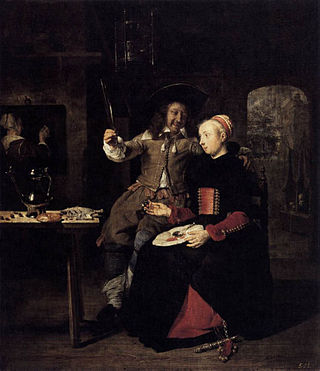
Gabriël Metsu (1629–1667) was a Dutch painter of history paintings, still lifes, portraits, and genre works. He was "a highly eclectic artist, who did not adhere to a consistent style, technique, or one type of subject for long periods". Only 14 of his 133 works are dated.

Hendrick Jansz ter Brugghen was a Dutch painter of genre scenes and religious subjects. He was one of the Dutch followers of Caravaggio – the so-called Utrecht Caravaggisti. Along with Gerrit van Hondhorst and Dirck van Baburen, Ter Brugghen was one of the most important Dutch painters to have been influenced by Caravaggio.

Jan Jacobszoon Hinlopen was a rich Dutch cloth merchant, an officer in the civic guard, a real estate developer in the Jordaan, alderman in the city council and a keen art collector. He would have been elected as a burgomaster, if he had not died at the age of forty, an age considered acceptable to be eligible. He was a prominent patron of the arts in his time, and there is some speculation on being an influential protector of Rembrandt and it is likely that he had good connections with Gabriel Metsu. Hinlopen, like his father-in-law, Joan Huydecoper I, is known in art history because of the poems by Jan Vos reciting the paintings in his house and members of the family. These paintings are spread all over the world, the poems nearly forgotten.

Lady Writing a Letter with her Maid is a painting by the Dutch artist Johannes Vermeer, completed in 1670–1671 and held in the National Gallery of Ireland, in Dublin. The work shows a middle-class woman attended by a housemaid who is presumably acting as messenger and go-between for the lady and her lover. The work is seen as a bridge between the quiet restraint and self-containment of Vermeer's work of the 1660s and his relatively cooler work of the 1670s. It may have been partly inspired by Ter Borch's painting Woman Sealing a Letter. The painting's canvas was almost certainly cut from the same bolt used for Woman with a Lute.

Jan Verkolje or Johannes Verkolje was a Dutch painter, draughtsman and engraver. He is mainly known for his portraits and genre pieces of elegant couples in interiors and, to a lesser extent, for his religious and mythological compositions. He was a gifted mezzotint artist. Trained in Amsterdam, Verkolje spent his active professional career in Delft where he had access to powerful patrons.

The Allegory of Faith, also known as Allegory of the Catholic Faith, is a Dutch Golden Age painting by Johannes Vermeer from about 1670–1672. It has been in the Metropolitan Museum of Art in New York since 1931.

Woman with a Lute, also known as Woman with a Lute Near a Window, is a painting created about 1662–1663 by Dutch painter Johannes Vermeer and now at the Metropolitan Museum of Art in New York.

Anthonie Palamedesz., also Antonie Palamedesz, birth name Antonius Stevens, was a Dutch portrait and genre painter. He is in particular known for his merry company paintings depicting elegant figures engaged in play, music and conversation as well as guardroom scenes showing soldiers in guardrooms. Like many Dutch painters of his time, he painted portraits and still lifes, including vanitas still lifes. He further painted the staffage in a few views of the interior of churches. He played a major role in the development of genre painting in Delft in the mid 17th century.

The Procuress is a 1656 oil-on-canvas painting by the then 24-year-old Johannes Vermeer. It can be seen in the Gemäldegalerie Alte Meister in Dresden. It is his first genre painting and shows a scene of contemporary life, an image of mercenary love perhaps in a brothel. It differs from his earlier biblical and mythological scenes. It is one of only three paintings Vermeer signed and dated. In 1696 the painting, being sold on an auction in Amsterdam, was named "A merry company in a room".

Self-Portrait is a 1665 niche painting by Gerrit Dou. It shows the artist at the peak of his fame, holding a palette and surrounded by studio objects. It is in the collection of the Metropolitan Museum of Art, in New York.

Banquet of the Amsterdam Civic Guard in Celebration of the Peace of Münster (1648) is a group portrait oil painting by the Dutch painter Bartholomeus van der Helst. It is an example of Dutch Golden Age painting and is considered one of the highlights of the Amsterdam Museum, though it is generally on show in the Rijksmuseum.
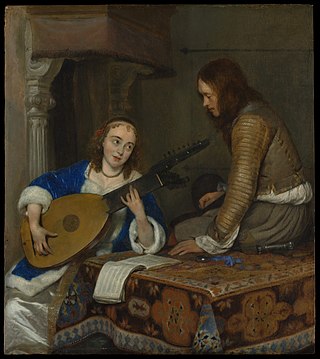
A Woman Playing the Theorbo-Lute and a Cavalier is aqn oil on wood painting by Dutch artist Gerard ter Borch the Younger, created c. 1658. The work depicts a young woman playing a theorbo while her lover looks on. The painting is in the collection of the Metropolitan Museum of Art, in New York.

Michiel Servaesz. Nouts or Nuyts was a Dutch Golden Age painter who also served as Amsterdam's town musician.
